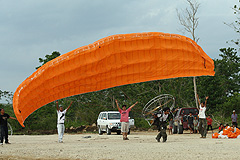Danao Airstrip Bohol’s New International Airport Panglao
 |
|
Image courtesy Girlie Cervantes
|
Bohol’s new international airport in the south of the island, to replace the overloaded Tagbilaran airport, has been ruminated for almost two decades, and work has still not commenced. By contrast, just eighteen months after its conceptual design, a new airstrip will be opened for business in central Bohol in August 2011, in the municipality of Danao.
Not quite the Bohol International Airport that the politicians have wanted to replace Tagbilaran Airport but the new airstrip in Danao is an example of what can be achieved in an apolitical environment with 100% support of the local community (typical of almost everything that happens in the remote, mountainous municipality of Danao, surrounded by Bohol’s famous Chocolate Hills).
The new Danao airstrip will host a flying school for air-heads & flying enthusiasts, using para-motors, ultralights and microlights. And, if you don’t have your own aircraft then you can rent one, for an hour or two or more.
The airstrip and flying school is the latest inspiration of Mayor Gonzaga, who has created an Extreme Adventure Tours playground (EAT-Danao) that spans the community and employs any resident who wants to get involved . . . and that is most of them. Within the Extreme Adventure Tours Danao development, you can go caving, kayaking, repelling, river trekking and rock climbing. Plus you can scare yourself silly with zip-lines, cable plunges and cable-basket rides that span the deep gorge above the Wahig River. A decade ago Danao was a fifth class municipality but today, because of the income generated by the Extreme Adventure Tours Danao, it has risen to a second class municipality, and has not yet reached its full potential.
So, if it is so easy to get things done in Danao, why is it that “down South”, in the municipality of Panglao, where the new international airport is slatted for development and “probably opening in 2014”, have the various political factions been battling with land acquisition and qualified resistance from indigenous residents and established migrant businesses for two decades? The main reason is that the indigenous residents and established migrant businesses don’t want the airport on Panglao Island.
Nobody seems to have a problem with the concept of a new international airport to service the unique Bohol island group, to replace the overloaded Tagbilaran airport facility. The main objections to siting it in the municipality of Panglao are that: (a) the municipality lacks voluminous fresh water supplies, has barely adequate electricity, does not have sufficient waste disposal areas and has very marginal sewage treatment (except for partially effective – because of the predominantly low elevations vs. sea level – septic tanks); (b) the levels of noise pollution for aircraft “up to Jumbo Jet size” will destroy Panglao’s famed tranquility – the island is actually rather small (15 kilometers end-to-end, and considerably less in girth) – as aircraft landing & taking off will be heard in every corner of the island, day and night; and, (c) the road network & bridges, connecting Panglao Island to Bohol Island, will become even more congested. It is only the new tourist ventures (mostly “luxury beach resorts” and “luxury hotels”) that seem enthusiastic about the new international airport being located in Panglao – so that they can fill the hundreds of new rooms that are coming on stream in 2011-2013, that have been built at some great expense.
Panglao Island is still somewhat untouched, apart from the areas adjacent to the many beautiful beaches, with large areas of lowland forest cover that provide shelter and forage for native lowland birds and animals, such as lizards & snakes. An international airport, such has been proposed, will take away a huge part of this essential habitat and confine the indigenous wildlife to ever decreasing pockets that will be increasingly less sustainable.
Apart from the voracious appetite of imported cats, that are allowed to run wild, the indigenous wildlife has been left largely untouched by humans – Panglaoeneos are far too well fed by the nearby oceans and the migrant property investors to indulge in predation on Mother Nature’s land based bounty. As a result the fauna has mostly survived the ravages of Man, to date. With an international airport the future of indigenous fauna will be terminal (pun intended).
What most of the indigenous residents and established migrant businesses would prefer is for the new airport to be located close to Tagbilaran, on the main island of Bohol. Partly because this would preserve the tranquility for which Panglao is famous and partly because today the majority of passenger traffic is destined for Tagbilaran City and places further North – thus avoiding congestion of the existing road network & bridges that link the two islands.
Who will win? Panglao apparently has the upper hand at the moment, so the island is most likely to be transformed into another Boracay – devoid of nature, except that which can be kept in cages for visitors to only gawk at.
However, if the new international airport was located close to Tagbilaran on Bohol Island, it would increase tourism throughout this uniquely positioned Bohol island group much faster, and allow “Bohol” to become the most visited eco-tourism and adventure sports center in Asia.
To get to the new airstrip in Danao, fly to Tagbilaran Airport and take road transport (about one hour) North to the Extreme Adventure Tours Danao at the Danao Adventure Park. Best advice is to book in advance, especially during peak holiday times, as the park is frequently overwhelmed with visitors and accommodations can be hard to secure if you arrive on a standby basis.
Links:
Extreme Adventure Tours Danao website

